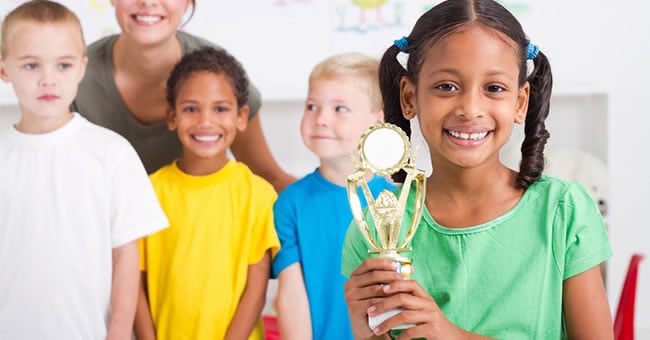
To reward or not to reward positive behavior in the classroom is a decision many teachers struggle making. Some educators argue that reward systems are only short-term fixes that encourage entitlement, while other educators believe that reward systems help establish a positive classroom environment and can be beneficial for all learners. Informal acknowledgement of positive behaviors (praising children verbally or with a smile or high five) is typically thought of as good practice—the source of contention for many educators are the formal reward and acknowledgement systems that use tangible items or social recognition to reward positive behaviors.
While William DeMeo, PhD, agrees that teachers shouldn’t use formal reward systems as a way to motivate students to learn, he does believe that formal reward systems can benefit children, especially when they are used to address challenging behavior. In When Nothing Else Works, DeMeo writes that, “Formal systems can be carried out in a way that includes children as proud participants and can reduce the discouraging feedback for negative behaviors. The children will feel empowered rather than minimized, neglected, or controlled.”
Designing an acknowledgement plan that outlines desired behaviors and how you want to acknowledge/reward those behaviors can help you implement an effective formal reward and acknowledgement system for the children in your care. Dr. William DeMeo provides the following steps, table, and system examples in When Nothing Else Works. You can use this information to make an acknowledgement plan, find a specific system, and choose the types of rewards you want to offer.
Making an Acknowledgement Plan
- Decide on a desired behavior to target. Make sure the targeted behavior is developmentally appropriate for the child and is something that you think the child can master.
- Identify the specific behavior you want to see increase.
- Determine where, when, and how often you will look to see if that behavior occurs.
- Think of ways to increase the likelihood of the child engaging in the desired behavior.
You also need to decide on which informal/formal reward and acknowledgement systems you want to use. Dr. DeMeo recommends that you use end-of-the-hour rewards for toddlers, end-of-the-day rewards for preschoolers, and end-of-the-week rewards for school-age children. Look at the chart at the bottom of the page for a few examples of preferred activities, social recognitions, and tangible items you can use as rewards.
Formal Reward and Acknowledgement System Ideas
- Use interactive chart movers to engage children and reinforce positive behaviors. Keep the chart visible in the room so children can see their daily progress.
- Give children a mystery motivator (a picture of a reward in an envelope) to open when they meet the specified criteria for the desired behavior.
- Label a spinner with specific rewards and have children spin the arrow to determine which formal reward/acknowledgement they receive. You can download a printable version of this reward and acknowledgement system here.
Once children are modeling more positive behaviors, start reducing the frequency of rewards. DeMeo recommends using an invisible-ink pen to draw smiley faces on some of a chart’s squares. If children meet behavior expectations, they can color in the square to see if a smiley face appears. They can have a reward if one appears, but they will have to wait until next time if one doesn’t appear. You can also gradually reduce the number of smiley faces you put on the chart with this method until formal rewards are no longer required.
Whether you choose to use informal and/or formal systems, it’s important that you take the time to acknowledge children’s positive behavior in some way. Be sure to read When Nothing Else Works for more information about acknowledging and rewarding positive behaviors. You can also browse our social-emotional resources for a variety of materials you can incorporate in your classroom.
Examples of Specific Rewards for Children
Preferred Activities
- Line Leader
- Lunch Helper
- Pick Book to Read
- Extra Time in a Center
- Sit Near Friend
- First on the Tricycle
- Choice of Activity
- Sitting Next to Teacher
Social Recognition
- Recognition Certificate
- Call Home to Parents
- Note Home to Parents
- Recognition at Circle Time
- Pictures on Board
- Holding a Special Item
- Recognition Necklace
- Recognition Pin
Tangibles
- Stickers
- Hand Stamps
- Small Toys
- Crayons or Markers
- Temporary Tattoo
- Smelling Box
- Feeling Box
- Unbreakable Mirror
